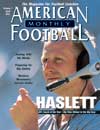AMERICAN FOOTBALL MONTHLY THE #1 RESOURCE FOR FOOTBALL COACHES
Article CategoriesAFM Magazine
|
The Best of Both Worldsby: Jane Musgrave© More from this issue As a youngster, Kathy Schniedwind was fascinated with medicine. "When I was in fourth grade I told people I wanted to be a doctor when I grew up," she says. But in addition to her interest in dissection kits, anatomy books and games like Operation, she was also drawn to the athletic field. An avid athlete, she played lacrosse, softball, field hockey, basketball and ran track in high school and college. So when it came time to pick a career, she knew she had to alter her fourth-grade plans. She wanted a job that would enable her to combine her two passions. And 25 years after she graduated with a master's degree in athletic training, she knows she made the right choice. "When I run out on the field with the team on game day it gives me chills," says Schniedwind, who has been head athletic trainer at Illinois State Univer....The full article can only be seen by subscribers.
|
|
|||||||
| HOME |
MAGAZINE |
SUBSCRIBE | ONLINE COLUMNISTS | COACHING VIDEOS |
Copyright 2025, AmericanFootballMonthly.com
All Rights Reserved





